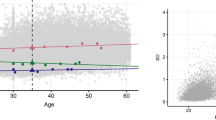Abstract
In the NHLI Twin Study MZ twins are shown to “get together” substantially more often than DZ twins. With this result as an indicator of differences in shared environment, the assumption of equal shared environmental variation for MZ and DZ twins is assessed using nutritional data calculated from a food frequency questionnaire. Six nutrients show significant genetic variance for the total sample. However, when stratified on the basis of how frequently twins see each other, none of the nutrients shows significant genetic variance for both strata. A similar pattern is seen for several individual items from the questionnaire. In addition, four of the nutrients show significant correlation between the absolute difference in the nutrient intake of MZ twin pairs and how often they “get together.” These data appear to show that unequal environmental effects may lead to falsely high estimates of genetic variance for nutrient intake.
Similar content being viewed by others
References
Christian, J. C., and Norton, J. A. (1975). Statistical analysis of genetic variance in twins.Am. J. Hum. Genet. 27:807.
Christian, J. C., Kang, K. W., and Norton, J. A. (1974). Choice of an estimate of genetic variance from twin data.Am. J. Hum. Genet. 26:154.
Epstein, L. M., Reshef, A., Abrahamson, J. H., and Bialik, O. (1970). Validity of a short dietary questionnaire.Israel J. Med. Sci. 6:589.
Faust, J. (1974). A twin study of personal preferences.J. Biosoc. Sci. 6:75.
Feinleib, M., Christian, J. C., Borhani, N. O.,et al. (1977). The NHLI twin study of cardiovascular disease risk factors: Organization and methodology.Acta Genet. Med. Gemellol. (in press).
Haseman, J. K., and Elston, R. C. (1970). Estimation of genetic variance from twin data.Behav. Genet. 1:11.
Hjortland, M. (1972). The effects of heredity and environment on nutrient intake of adult monozygotic and dizygotic twins. Doctoral dissertation, University of Minnesota.
Jablon, S., Neel, J. V., Gershowitz, H., and Atkinson, G. F. (1967). The NAS-NRC Twin Panel: Methods of construction of the panel, zygosity diagnosis and proposed use.Am. J. Hum. Genet. 19:133.
Kempthorne, O., and Osborne, R. H. (1961). The interpretation of twin data.Am. J. Hum. Genet. 13:320.
Koch, H. L. (1966).Twins and Twin Relations, University of Chicago Press, Chicago.
Loehlin, J. C. (1974). Empirical methods in quantitative human behavior genetics. Presented at the Workshop on Developmental Human Behavior Genetics, Bethesda, Md.
National Diet Heart Study Research Group (1968). National Diet Heart Study final report.Circulation 37:125 (Suppl. 1).
Plomin, R., Willerman, L., and Loehlin, J. C. (1976). Resemblance in appearance and the equal environments assumption in twin studies of personality traits.Behav. Genet. 6:43.
Scheinfeld, A. (1968).Twins and Supertwins, Chatto and Windus, London.
Schwartz, J. T., and Feinleib, M. (1974). Twin reliability study. In Goldberg (ed.),Genetic and Metabolic Eye Disease, Little, Brown, Boston.
Smith, R. T. (1965). A comparison of socioenvironmental factors in monozygotic and dizygotic twins, testing an assumption. In Vandenberg, S. G. (ed.),Methods and Goals in Human Behavior Genetics, Academic Press, New York.
Tucker, R. (unpublished). University of Rhode Island study of college freshman—Report of usual eating habits.
Vandenberg, S. G. (1966). Contributions of twin research to psychology.Psychol. Bull. 66:5.
Author information
Authors and Affiliations
Rights and permissions
About this article
Cite this article
Fabsitz, R.R., Garrison, R.J., Feinleib, M. et al. A twin analysis of dietary intake: Evidence for a need to control for possible environmental differences in MZ and DZ twins. Behav Genet 8, 15–25 (1978). https://doi.org/10.1007/BF01067701
Received:
Accepted:
Issue Date:
DOI: https://doi.org/10.1007/BF01067701




